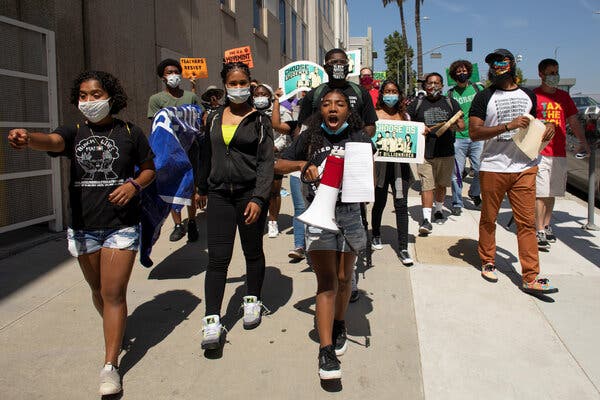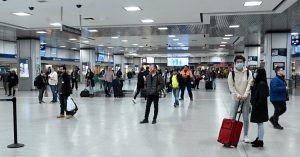WASHINGTON — Republicans and Democrats in Congress say they agree that a new stimulus package must include billions of dollars to help schools struggling financially and logistically to resume education this month and next.
But the parties are digging in over profound ideological differences, especially the divide between Democratic demands for public education spending and a Republican push to channel federal dollars into vouchers that families could use at private schools willing to open for in-person classes.
Caught in the middle are the nation’s educators — public and private alike — who say their classrooms are becoming collateral damage in the protracted stalemate.
“The longer we have to wait for support, the more precarious reopening becomes,” said Sonja Santelises, the chief executive of the Baltimore school system, who announced a virtual start to the school year but is hoping that federal aid can help classes begin in person early next year. “It’s unfortunate, quite frankly, that as a nation we have now made schools a political football. That is going to have a long-term impact, without a doubt.”
Money for schools has bipartisan support. Democrats included about $100 billion for elementary, secondary and higher education in the $3.4 trillion stimulus package the House passed in May. Senate Republicans included $105 billion for schools in the $1 trillion stimulus plan they unveiled last month.
But the Republican package sets aside at least 10 percent of its K-12 funding for private and religious schools and would make good on Education Secretary Betsy DeVos’s long-promised Education Freedom Scholarships, which would provide federal tax credits for donations to state-based scholarship programs for private schools.
Republicans also want to tie some of the education aid to the reopening of schools for in-person classes, a position favored by President Trump and Ms. DeVos.
Teachers’ unions and some public education boosters say those provisions show that the Trump administration is more interested in using the coronavirus crisis to push for school privatization than in saving public school districts.
“The Republicans are using teachers and students like bargaining chips,” said Randi Weingarten, the president of the 1.7-million-member American Federation of Teachers. “They’ve been successful at creating chaos,” she added.
The Democrats’ proposal contains no money for private schools, nor does it tie federal aid to in-person classes. It contains $875 billion for state and local governments, whose fiscal health, supporters say, is key to assuring stable funding for public schools.
But private and religious educators say Democrats are not recognizing the existential threat facing their schools. While many private schools have received small-business loans through the federal Paycheck Protection Program, the pandemic’s hit to their bottom lines has been so brutal that some schools have no choice but to close their doors, including Speaker Nancy Pelosi’s alma mater, the Institute of Notre Dame in Baltimore.
Last week, the U.S. Conference of Catholic Bishops wrote to Representative Karen Bass, Democrat of California and the chairwoman of the Congressional Black Caucus, urging Congress to support federal emergency relief funds for Catholic schools in urban areas that are in “crisis.”
More than 130 Catholic schools have already announced permanent closures in Chicago, Philadelphia, Baltimore, Boston, New York and elsewhere, the bishops wrote. The letter asked for Congress to designate emergency funding for direct scholarship aid to low-income private school families.
The Coronavirus Outbreak
Back to School
Updated Aug. 5, 2020
The latest highlights as the first students return to U.S. schools.
-
- After parents and teachers opposed a hybrid model of in-person and online learning, Chicago Public Schools, the nation’s third-largest district, will reopen online only.
- New York City faces a torrent of logistical and political issues that could upend efforts to bring students back to classrooms.
- Gov. Larry Hogan of Maryland overruled a county health directive that would have closed some of the nation’s most elite private schools, fueling a national debate over equity.
- What could going to school look like in the age of Covid-19? See our illustrated guide.
“As the impact of the coronavirus has disproportionately affected the Black community, the same is true for our Catholic schools that serve predominately Black communities, and we are imploring your help for these families who have sought a Catholic education for their children,” wrote Bishops Michael C. Barber, Shelton J. Fabre and Joseph N. Perry.
Nathan J. Diament, the executive director for public policy for the Union of Orthodox Jewish Congregations of America, said private schools, which rely on tuition and donations during a deep recession, were facing acute challenges.
“This needs to be looked at as an emergency response in a crisis situation,” Mr. Diament said. “This is more akin to Hurricane Katrina and Superstorm Sandy than the typical discussions we have about federal support for education.”
Leading Democrats have said they want to take care of public schools first.
In negotiations with Mark Meadows, the White House chief of staff, and Treasury Secretary Steven Mnuchin, Ms. Pelosi and Senator Chuck Schumer of New York, the Democratic leader, have increased the amount of aid they believe needs to go to public schools.
Initially Ms. Pelosi included $100 billion for schools in the House bill; now Democratic leaders want four times that amount — $430 billion for public education, including $175 billion for K-12 schools and $50 billion for child care.
“When we had $100 billion in our plan, we knew it wasn’t enough, but we had to get a bill passed,” Ms. Pelosi told Ms. Weingarten during a virtual interview at a teachers’ union convention. “Your friend Chuck Schumer has it up to $400 billion, thanks to you.”
Republicans, in contrast, are not united. During talks on the party’s Senate proposal, administration officials pushed to allocate funding only to schools that had opened in person, but the senators resisted taking the decision on reopening away from state and local governments and school districts. Republicans settled on proposing that of the $70 billion earmarked for primary and secondary schools, two-thirds of that money would go to schools that had some form of in-person classes.
“If what you’re asking is, ‘Should we threaten to cut off funds to districts that don’t open?’ I’m not supportive of it,” said Senator Marco Rubio, Republican of Florida.
Senator Mike Rounds, Republican of South Dakota, is more supportive. Some schools in his state are opening with separation barriers to keep students in small groups of about a dozen, and Mr. Rounds said it made sense to provide more money for schools that have the costs of running in-person classes.
Representative Rosa DeLauro, Democrat of Connecticut and the chairwoman of the subcommittee that oversees education spending, said linking education funding to in-person instruction was “mindless and ill informed.”
“No parent is going to send their child to a school that is not deemed to be safe,” Ms. DeLauro said.
The impasse in Washington is taking a toll elsewhere.
Elsie Arntzen, Montana’s superintendent of public instruction, said her agency rushed out the $41 million it received in an earlier stimulus package to help school districts in her largely rural state, where most schools have fewer than 50 students.
Social-distancing rules on school buses in Montana mean “double the costs for transporting safely our students back and forth to school,” Ms. Arntzen said.
She is urging Congress to give local school systems flexibility, rather than dictating spending from Washington, as districts brace for the impact of both the coronavirus and the seasonal flu.
“In Montana, we have cold winters, and cold winters sometimes bring that flu season that is very hard on all kinds of populations, whether it be in rural Montana or on our reservations,” she said.
In Baltimore, Ms. Santelises said she was worried about having enough federal support to reopen safely. But she is also concerned about the looming budget deficit that her chronically underfunded school system is sure to face from the economic downturn.
“We need some kind of federal stimulus,” Ms. Santelises said. “People think that it’s just a discussion about hybrid or virtual teaching, but really the long-term financial viability of school systems is definitely under great strain and pressure right now.”
Emily Cochrane and Erica L. Green contributed reporting.



















